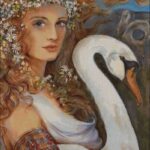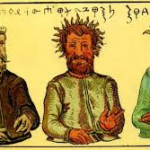In Lithuanian mythology, Vaiva is a significant figure that represents the essence of nature and the intricate connection between the human world and the natural environment. This mythological character embodies the harmony and balance that Lithuanians have traditionally sought in their relationship with the earth. The stories surrounding Vaiva often illustrate the importance of respecting nature and understanding the consequences of one’s actions. This article will delve into the various aspects of Vaiva, exploring her origins, symbolism, and the role she plays in Lithuanian folklore.
Origins of Vaiva
The origins of Vaiva can be traced back to ancient times when the Lithuanian people began to form their understanding of the world around them. In the early stages of their culture, they created myths and legends to explain natural phenomena and to provide a framework for their beliefs. Vaiva is often associated with the rainbow, which is seen as a bridge between the earth and the sky, connecting the physical and spiritual realms. This symbolism highlights the idea that Vaiva is a messenger or a guide, leading people towards enlightenment and understanding.
 Laime
LaimeAccording to various legends, Vaiva is often depicted as a beautiful woman adorned with vibrant colors, representing the various hues of the rainbow. Her presence is said to bring joy and hope to those who encounter her, as she symbolizes the beauty of nature and the promise of renewal. In many stories, she appears during times of hardship, reminding people of the importance of perseverance and the rewards that come from respecting the natural world.
Symbolism of Vaiva
Vaiva holds a multitude of symbolic meanings within Lithuanian mythology. One of her primary associations is with the rainbow, which signifies hope, beauty, and the connection between different realms. The rainbow is often viewed as a symbol of peace and tranquility, bridging the gap between the earthly and the divine. In this sense, Vaiva serves as a reminder of the importance of maintaining harmony in one’s life and the world around them.
Additionally, Vaiva represents the cycle of life. Just as the rainbow appears after a storm, she symbolizes the idea that difficult times will eventually pass, leading to brighter days. This cyclical nature is deeply rooted in Lithuanian culture, where the changing seasons and natural cycles are revered. Vaiva embodies the resilience of nature and the human spirit, reminding individuals to remain hopeful even in the face of adversity.
 Krumine
KrumineVaiva in Folklore
In Lithuanian folklore, Vaiva is often featured in stories that highlight her role as a protector of nature and a guide for humanity. Many tales depict her interacting with various elements of the natural world, such as animals, plants, and celestial bodies. Her presence in these stories serves to emphasize the interconnectedness of all living beings and the importance of maintaining balance within the ecosystem.
One popular tale involves Vaiva helping a lost traveler find their way home. In this story, the traveler encounters numerous obstacles, including harsh weather and treacherous terrain. Just when hope seems lost, Vaiva appears as a radiant figure, guiding the traveler with her colorful light. This narrative not only illustrates her role as a protector but also emphasizes the idea that help can come from unexpected sources, often rooted in the natural world.
Vaiva’s Connection to Nature
- Vaiva symbolizes the beauty of the natural world.
- She represents the importance of preserving nature.
- Her stories highlight the interconnectedness of all living beings.
 Kremata
KremataVaiva’s connection to nature is a central theme in many Lithuanian myths. She is often seen as a guardian of forests, rivers, and wildlife, embodying the spirit of the land. This connection serves as a reminder of the responsibility that humans have to protect and respect their environment. In various legends, she is depicted as nurturing the plants and animals, ensuring that they thrive and flourish.
Furthermore, Vaiva’s role in nature extends to the changing seasons. She is often portrayed as a figure who ushers in the arrival of spring, bringing life and renewal after the harshness of winter. This cyclical relationship with the seasons reinforces the idea that life is a continuous journey, filled with ups and downs, but ultimately leading to growth and transformation.
Celebrations and Rituals
In Lithuania, various celebrations and rituals are held to honor Vaiva and her connection to nature. These events often coincide with the changing seasons, particularly during the spring and summer months when the natural world is at its most vibrant. One such celebration is the festival of Jūratė and Kastytis, which pays homage to the Baltic Sea and the deities associated with it, including Vaiva. During this festival, people engage in various activities such as singing, dancing, and crafting colorful decorations that symbolize the beauty of nature.
Additionally, rituals involving the planting of crops and the honoring of the earth are often linked to Vaiva. These practices serve as a way for communities to express gratitude for the bountiful harvests and to seek her blessings for future prosperity. By acknowledging her presence, people reinforce their commitment to respecting and nurturing the land that sustains them.
Ritual Practices
- Offering prayers to Vaiva during planting season.
- Creating colorful decorations to symbolize her presence.
- Participating in community gatherings to celebrate nature.
During these rituals, offerings are often made to Vaiva in the form of flowers, fruits, and other natural elements. These gifts symbolize gratitude and respect for the earth and its resources. Participants may gather in groups to share stories about Vaiva, reinforcing the cultural significance of her character and the lessons she imparts about living in harmony with nature.
In addition to seasonal celebrations, many Lithuanians also practice personal rituals to honor Vaiva in their daily lives. These practices may include spending time outdoors, planting gardens, or simply taking a moment to appreciate the beauty of the natural world. By incorporating Vaiva’s teachings into their lives, individuals can cultivate a deeper connection to the environment and a greater understanding of their role within it.
Vaiva in Modern Culture
In contemporary Lithuania, Vaiva continues to hold a special place in the hearts of many people. Her stories and symbolism have been embraced by modern artists, writers, and musicians who draw inspiration from her character and the themes she represents. This resurgence of interest in Vaiva reflects a broader movement within society to reconnect with nature and explore the rich cultural heritage of the Lithuanian people.
Many artists incorporate elements of Vaiva into their work, using vibrant colors and natural motifs to evoke the beauty of the landscape. This artistic expression serves as a reminder of the importance of preserving nature and celebrating its wonders. Furthermore, Vaiva’s stories are often retold in various forms, including literature and theater, allowing new generations to engage with her character and the values she embodies.
Modern Interpretations
- Artists create works inspired by Vaiva’s symbolism.
- Writers retell her stories for contemporary audiences.
- Musicians compose songs that celebrate her connection to nature.
In literature, Vaiva is often portrayed as a symbol of resilience and hope, reflecting the struggles and triumphs of the Lithuanian people. Writers explore her character in various contexts, examining the relationship between humanity and the natural world. Through these narratives, readers are encouraged to reflect on their own connections to the environment and the importance of preserving it for future generations.
Musicians also play a vital role in keeping Vaiva’s spirit alive. Many songs draw upon her themes of nature, beauty, and renewal, resonating with listeners who seek solace and inspiration in the natural world. These musical interpretations serve as a bridge between traditional mythology and contemporary culture, allowing Vaiva’s legacy to endure and evolve.
Lessons from Vaiva
The stories of Vaiva offer valuable lessons that extend beyond the realm of mythology. One of the most important teachings is the significance of respecting nature and recognizing the interconnectedness of all living beings. Vaiva embodies the idea that every action has consequences, and by caring for the environment, individuals can contribute to the well-being of the planet and future generations.
Another key lesson from Vaiva’s stories is the importance of resilience and hope. Her character serves as a reminder that even in challenging times, there is always the potential for renewal and growth. This perspective encourages individuals to face adversity with courage and optimism, knowing that brighter days are ahead.
Practical Applications
- Engaging in sustainable practices to protect the environment.
- Promoting community initiatives focused on nature conservation.
- Encouraging mindfulness and appreciation for the natural world.
In practical terms, the lessons of Vaiva can be applied in various ways. Engaging in sustainable practices, such as reducing waste and supporting local agriculture, can help protect the environment and promote a healthier planet. Additionally, participating in community initiatives focused on nature conservation can foster a sense of collective responsibility and empower individuals to make a positive impact.
Moreover, encouraging mindfulness and appreciation for the natural world can lead to a deeper understanding of the environment and its significance in our lives. By taking the time to observe and connect with nature, individuals can cultivate a sense of gratitude and respect for the earth, mirroring the values that Vaiva embodies.
The Future of Vaiva in Lithuanian Culture
As Lithuania continues to evolve in a modern context, the future of Vaiva in Lithuanian culture remains bright. The ongoing interest in her stories and symbolism suggests that she will continue to be an essential figure in the collective consciousness of the Lithuanian people. As more individuals seek to reconnect with their cultural roots and the natural world, Vaiva’s teachings will likely resonate even more strongly.
Educational initiatives that focus on Lithuanian mythology and folklore can play a crucial role in preserving Vaiva’s legacy. By introducing younger generations to her stories, schools and community organizations can foster a sense of pride in cultural heritage and inspire individuals to carry forward the values she represents. This emphasis on education can help ensure that Vaiva remains a vibrant part of Lithuanian culture for years to come.
Community Engagement
- Encouraging local storytelling events.
- Hosting workshops on nature conservation.
- Creating art installations inspired by Vaiva.
Community engagement is also vital in keeping Vaiva’s spirit alive. Organizing local storytelling events that celebrate her tales can bring people together and create a sense of unity. Workshops focused on nature conservation can educate individuals about the importance of protecting the environment, reinforcing the lessons that Vaiva embodies. Additionally, creating art installations inspired by her character can serve as a visual reminder of the beauty of nature and the significance of preserving it.
Vaiva is a powerful symbol within Lithuanian mythology, representing the deep connection between humanity and the natural world. Her stories, rich in symbolism and meaning, offer valuable lessons about respect, resilience, and hope. As Lithuania continues to navigate the complexities of modern life, the enduring legacy of Vaiva will undoubtedly inspire future generations to honor and protect the environment, fostering a harmonious relationship with nature that transcends time and culture.
